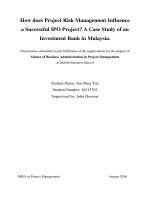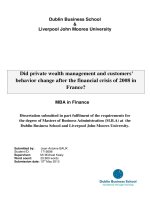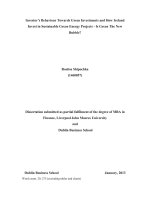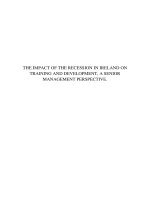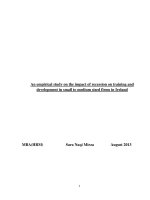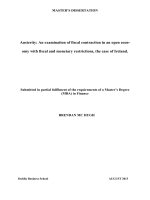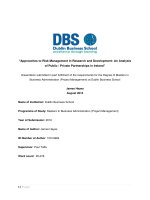Master Thesis in Economics: Staff and management perception of the change management process: The case of Carphone Warehouse business integration between British and Irish operations in
Bạn đang xem bản rút gọn của tài liệu. Xem và tải ngay bản đầy đủ của tài liệu tại đây (1.15 MB, 158 trang )
Staff and management perception of the change management process.
The case of Carphone Warehouse business integration between
British and Irish operations in 2011-12
By: Lukasz Wojcik (1242821)
A dissertation submitted in partial fulfillment of the requirements of the
Project Management Masters in Business Administration degree
at Dublin Business School
in conjunction with
Liverpool John Moores University
Supervisor: Claire Devlin
May 2013
TABLE OF CONTENT
TABLE OF CONTENT ..................................................................................................................... 2
LIST OF FIGURES AND TABLES .................................................................................................. 5
DECLARATION ................................................................................................................................7
ACKNOWLEDGEMENT .................................................................................................................. 8
CHAPTER 1: INTRODUCTION....................................................................................................... 9
1.1. Background of the issue ........................................................................................................... 9
1.2. Research Objectives ...............................................................................................................10
1.3. Research Hypothesis ..............................................................................................................10
1.5. Research Recipients...............................................................................................................11
1.6. Suitability of the Researcher .................................................................................................. 11
1.7. Interest in the subject..............................................................................................................12
1.8. Organisation of the Research................................................................................................. 12
1.9. Structure of the study..............................................................................................................13
CHAPTER 2: LITERATURE REVIEW ..........................................................................................14
2.1. Introduction..............................................................................................................................14
2.2. Change Management. Schools of thought ............................................................................14
2.3. Planned and Emergent approach to change .........................................................................15
2.4. Reasons for change................................................................................................................16
2.5. Critical success factors for a successful change................................................................... 19
2.5.1. Shared services ...................................................................................................................23
2.6. Leadership...............................................................................................................................23
2.6.1. Transformational leadership................................................................................................24
2.7. Transition................................................................................................................................. 27
2.8. Literature review conclusion ................................................................................................... 28
CHAPTER 3: REASERCH METHODS AND METHODOLOGY..................................................30
3.1. Introduction..............................................................................................................................30
3.2. Research Philosophy ..............................................................................................................31
3.2.1. Positivism ............................................................................................................................ 31
3.2.2. Interpretivism....................................................................................................................... 32
3.2.3. Research Philosophy Choice ............................................................................................. 32
3.3. Research Approaches ............................................................................................................32
3.3.1. Deductive Approach ........................................................................................................... 33
2
3.3.2. Inductive Approach ............................................................................................................. 33
3.3.3. Research Approach Choice ............................................................................................... 34
3.4. Research Strategy ..................................................................................................................34
3.5. Research Choice ....................................................................................................................35
3.6. Time Horizons .........................................................................................................................35
3.7. Research population and sample...........................................................................................35
3.8. Research data collection methods .........................................................................................36
3.8.1. Secondary data ................................................................................................................... 37
3.8.2. Primary Data ....................................................................................................................... 37
3.9. Interview preparation ..............................................................................................................38
3.10. Questionnaire design process..............................................................................................39
3.11. Ethical Issues ........................................................................................................................42
CHAPTER 4: RESEARCH RESULTS ..........................................................................................43
4.1. Introduction..............................................................................................................................43
4.2. Results of the Interviews ........................................................................................................43
4.2.1. Perception of the integration process ................................................................................ 44
4.2.2. Change ................................................................................................................................ 44
4.2.3. Expectations........................................................................................................................ 45
4.2.4. Leadership .......................................................................................................................... 46
4.2.5. Transition............................................................................................................................. 46
4.2.6. Solutions and recommendation for the future ................................................................... 47
4.3. Results of the Questionnaire .................................................................................................. 49
4.3.1. Number of responders ........................................................................................................ 49
4.3.2. Characteristic of responders .............................................................................................. 50
4.3.3. Change ................................................................................................................................ 54
4.3.4. Reasons for change............................................................................................................ 55
4.3.5. Critical success factors ....................................................................................................... 58
4.3.6. Expectations........................................................................................................................ 62
4.3.7. Leadership .......................................................................................................................... 65
4.3.8. Transition............................................................................................................................. 67
4.3.9. Overall success of the organisational change in the Carphone Warehouse ................... 73
CHAPTER 5: RESEARCH DISCUSSION AND CONCLUSION..................................................76
5.1. Introduction..............................................................................................................................76
5.2. Research Objectives Achieved ..............................................................................................76
3
5.2.1. Reasons for change............................................................................................................ 76
5.2.2. Critical success factors for a successful change............................................................... 77
5.2.3. Staff and management expectations ................................................................................. 77
5.2.4. Leadership during the integration process ........................................................................ 78
5.2.5. Challenges during the transition ........................................................................................ 78
5.2.6. Success of the organisational change ............................................................................... 79
5.3. Research Hypothesis..............................................................................................................80
5.4. Recommended areas of further study ...................................................................................80
CHAPTER 6: RESEARCH RECOMMENDATIONS .....................................................................81
6.1. Introduction..............................................................................................................................81
6.2. Project Management...............................................................................................................81
6.3. Leadership...............................................................................................................................82
6.4. Employee engagement and communication .........................................................................83
6.5. Sustainability ...........................................................................................................................84
CHAPTER 7: REFLECTIVE LEARNING ......................................................................................85
7.1. Introduction..............................................................................................................................85
7.2. Learning Styles .......................................................................................................................85
7.3. Reflections on Learning ..........................................................................................................87
7.3.1. Research skills .................................................................................................................... 88
7.3.2. Finance................................................................................................................................ 89
7.3.3. Time Management .............................................................................................................. 89
7.4. Future application of learning ................................................................................................. 90
APPENDICES ..............................................................................................................................100
Appendix 1: Carphone Warehouse Dublin region ......................................................................100
Appendix 2: Company background .............................................................................................101
Appendix 3: Interview questions.................................................................................................. 102
Appendix 4: Detailed notes from the interviews .........................................................................103
Appendix 5 : Questionnaire .........................................................................................................120
Appendix 6: Consent Form for participation in Interview Research...........................................127
Appendix 7: Email sent over to the research population............................................................130
Appendix 8: Cross tabbed responses to the questionnaire .......................................................131
Appendix 9: Research Project Plan ............................................................................................158
Appendix 10: Research Project Cost ..........................................................................................158
4
LIST OF FIGURES AND TABLES
Figure 1: The research process ....................................................................................................12
Figure 2: The effectiveness matrix ................................................................................................19
Figure 3: Leading Change Model .................................................................................................. 22
Figure 4: Transformational Leadership .........................................................................................25
Figure 5: Transactional management v transformational leadership ..........................................26
Figure 6: The research onion ........................................................................................................30
Figure 8: Breakdown of employees managing at least 1 person.................................................50
Figure 9: Involvement in decision making process during the integration................................... 51
Figure 10: Breakdown of responders work service ......................................................................52
Figure 11: Breakdown of responders work channel .....................................................................53
Figure 12: Integration process ratings...........................................................................................55
Figure 13: Reasons for change breakdown ..................................................................................57
Figure 14: Understanding of reasons for change .........................................................................58
Figure 15: Critical success factors breakdown .............................................................................60
Figure 16: Breakdown of critical success factors during the change...........................................62
Figure 17: Breakdown of expectations from the integration process ..........................................64
Figure 18: Breakdown of the fulfilment of staff level of expectations ..........................................65
Figure 19: Breakdown of the satisfaction level with Leadership Team .......................................67
Figure 20: Breakdown of preparation level for the change process ............................................68
Figure 21: Breakdown of employees’ state of mind .....................................................................70
Figure 22: Breakdown of the level of support ...............................................................................71
Figure 23: Shared Services support ratings .................................................................................73
Figure 24: Organisational change success ratings ......................................................................74
Table 1: External drivers triggering change ..................................................................................17
Table 2: Internal drivers triggering change ...................................................................................18
Table 3: Practices helping change ................................................................................................20
Table 4: Breakdown of responders company join date ................................................................49
Figure 7: Breakdown of responders company join date...............................................................49
Table 5: Breakdown of employees managing at least 1 person ..................................................50
5
Table 6: Involvement in decision making process during the integration ....................................51
Table 7: Breakdown of responders work service..........................................................................52
Table 8: Breakdown of responders work channel ........................................................................53
Table 9: Integration process ratings ..............................................................................................54
Table 10: Reasons for change breakdown ...................................................................................56
Table 11: Understanding of reasons for change ..........................................................................57
Table 12: Critical success factors breakdown ..............................................................................59
Table 13: Breakdown of critical success factors during the change............................................61
Table 14: Breakdown of expectations from the integration process............................................63
Table 15: Breakdown of the fulfilment of staff level of expectations............................................65
Table 16: Breakdown of the satisfaction level with Leadership Team.........................................66
Table 17: Breakdown of preparation level for the change process .............................................68
Table 18: Breakdown of employees’ state of mind.......................................................................69
Table 19: Breakdown of the level of support ................................................................................71
Table 20: Shared Services support ratings...................................................................................72
Table 21: Organisational change success ratings........................................................................74
6
DECLARATION
I declare that all the work in this dissertation is entirely my own unless otherwise stated and
referenced with the original source.
A detailed reference section is included within this dissertation.
No portion of the work referred to in this dissertation has been submitted for assessment, in
any form, either at Dublin Business School or any other university or institute of learning.
Signed: ________________________
Date: __________________________
7
ACKNOWLEDGEMENT
This dissertation could not have been written without the support of many people who have
encouraged and supported me throughout the writing of this dissertation.
To the academic staff of Dublin Business School who provided guidance and support
throughout the whole MBA journey. To my research dissertation supervisor, Claire Devlin, who
kept me on the right track and encouraged to continue the hard work at all times.
To the leadership team and staff of the Carphone Warehouse without whom this research
could not have taken place.
Finally, but most importantly, I would like to express my sincere thanks and appreciation to my
whole family, especially to my uncle Zbyszek who has supported me throughout the whole
MBA journey.
None of that would have happened without support and encouragement from my wife Karolina
and my beautiful baby girl Zosia. I love you very much and this MBA is as much yours as it is
mine!
8
CHAPTER 1: INTRODUCTION
1.1. Background of the issue
The economic environment is challenging for all retailers. Increased competition on the high
street, alternative online sales channels and consumer, who is spending less and has now
more choices than ever before, requires the organisation to change in order to survive.
Organisational change is a constant challenge for all businesses across the globe (CowanSahadath, 2010) and the emphasis of today’s management literature is sending a clear
message that companies must change in order to survive (Ojiako et al., 2008). Pioch (2007)
highlights that service sector and retail in particular has developed into an economic force with
increasing level of internationalisation. Competition between national and multi-national
companies went to the new level and all corporations are looking to maximise opportunities
and minimise costs based on that trend. Current fast paced business environment with
accelerating changes in technology (Cowan-Sahadath, 2010), higher customer expectations
(Yen-Hao et al., 2010) requires constant change to remain successful. (Ojiako et al., 2008).
Research shows that over 60% of all change projects are considered to fail, therefore it is vital
to recognise that successful change is difficult to be achieved (Burnes, 2004).
In 2008 the worldwide financial crisis affected all sectors of global economy triggering
substantial, long term consequences which are still visible in the services sector. Over the
years many different strategies, business plans and operational tactics have been introduced
in order to change or improve the financial status and performance of the retail area.
Considerable restructuring and down-sizing have been introduced in many industries in order
to decrease an impact of the financial collapse (Von Friedrichs et al., 2009).
The Carphone Warehouse, the largest independent mobile phone retailer in Europe with over
2,300 stores, is among many organisations that are looking into various ways for improvement
of its economic status. The Company could no longer remain in the same position and in order
to stay competitive on the marketplace went through number of changes over the past 4 years.
The organisation went through another major change in 2011 resulting in Irish and British
divisions integrating their operations.
9
The literature review has shown lack of research carried out in Ireland that would present wider
retail management structure from the perspective of the change management in the
organisation. The available materials are limited; moreover the reasons for change and critical
success factors are very often described in a broad context and are not well ranked.
The author will investigate Dublin region1 staff and management perception of change based
on the business integration between the Irish and British division of the Carphone Warehouse
Group2.
1.2. Research Objectives
According to Saunders et al. (2007:32) the research objectives express the “researcher’s
sense of the purpose and direction”. The following objectives will assist in achieving the
primary aim of the research:
- To define reasons for change in the organisation.
- To determine what staff and management perceive as the critical success factors for a
successful change.
- To establish if the integration process has fulfilled staff and management expectations.
- To establish if leaders did effectively lead the business during the integration according to
managers and staff.
- To establish challenges during the transition period for the Carphone Warehouse employees.
- To establish if the organisational change was successful according to managers and staff.
1.3. Research Hypothesis
Kumar (2005) states that research hypothesis enhance the objective of a study and also
provide the study with focus on the subject matter. According to Saunders et al. (2007:117)
hypothesis is a “testable proposition about the relationship between two or more concepts and
variables”.
1
2
Overview of Carphone Warehouse Dublin region is included in Appendix 1
Overview of the Company background is included in Appendix 2
10
The research hypothesis that author will look to prove or disprove is:
The perception of change management in the Carphone Warehouse Dublin region based on
the integration between Irish and British operations was successful according to staff and
management.
1.5. Research Recipients
The dissertation will be submitted in part fulfilment of the Dublin Business School MBA
programme in conjunction with Liverpool John Moore’s University. The principal recipients will
be the dissertation supervisor Claire Devlin. The research will be of interest to the Carphone
Warehouse Ireland Board of Directors, who would welcome a lesson learned from the change
implemented in 2011. There is an opportunity to examine the change process in Carphone
Warehouse with increased emphasis on staff and management perception of change, to
identify critical success factors, understand the problems and with enough research evidence,
to suggest potential solutions. This topic will be also interesting to many professionals, who will
be going through the change management process in their organisations.
1.6. Suitability of the Researcher
Over the past five years of his work in the Carphone Warehouse the author went through
number of changes within the business while in different positions and departments. The
author’s professional background and excellent relationships across the company makes him
well suited to carry out this research effectively with a strong emphasis on delivering
comprehensive outcome. A strong commercial, customer and project management
background that author poses will provide additional dimension to the overall scope of the
change management research.
11
1.7. Interest in the subject
The author went through the change management process twice while working in the
Carphone Warehouse. He feels that in both cases there was a room for improvement in terms
of the overall process delivery. On top of that the current business environment is very
challenging and the researcher feels that he might be going through more change
management processes in the future. Every single business in order to sustain its success
ratio needs to evolve; especially now due to the fast paced changes that appears in business
environment. Currently there is an increased emphasis on the change management
processes, but it is unclear which factors are making that process successful. The dissertation
will contribute to that knowledge by determining what employees and managers perceive as
the critical success factors for an effective change. This particular subject will be very
interesting to many professionals who will be going through the change management process
in the future.
1.8. Organisation of the Research
In order to carry out a quality study, which will deliver an accurate insight to the examined
problem, author has adopted the research process shown in Figure 1.
Figure 1: The research process
Adopted from Bernie (2012)
12
1.9. Structure of the study
The dissertation is divided into seven chapters.
Introduction to the dissertation is being provided in chapter one. This chapter outlines a
background to the research issue, research objectives and hypothesis. It also identifies the
reasons for the researcher’s interest.
Chapter two undertakes an extensive review of existing literature in relation to the research
area based on the various sources including books, online journals, articles and internet
materials. All the sources used to critically evaluate the issue are listed in the references
section and divided into three main sections: books, articles and internet.
Chapter three explains the research methodology, design and strategy, which have been used
in order to prove or disprove the dissertation hypothesis. This chapter offers also reasoning for
each approach applied in the study by the author.
In chapter four author presents the findings of the research gathered based on qualitative and
quantitative methods of data collection.
Chapter five draws conclusions based on the collected data from interviews and questionnaire.
Recommendations based on the data analysed are available in Chapter six. This part includes
what the researcher believes might be the future proof solution in relation to the change
management in the retail orientated organisation in Ireland.
Finally, chapter seven describes researcher’s self-reflection on the dissertation project and the
overall MBA programme. Author also analyses future applications of learning’s.
13
CHAPTER 2: LITERATURE REVIEW
2.1. Introduction
This chapter explores the emerging area of change in organisation, demonstrates and
analyses different approaches to change process and examines reasons for change. It also
attempts to identify reasons for change, critical success factors associated with driving change
in organisation and studies the impact of the transition process.
Although there is an extensive literature available in relation to the change management,
author decided to present critical success factors and transition from a general perspective, as
the reviewed literature presented lack of contrasting views and different schools of thought.
2.2. Change Management. Schools of thought
The available literature on change management describes it as a discipline with unclearly
defined boundaries, interconnected with number of social science theories and practices.
Burnes (2009) recognises that and limits the examination of the change management
theoretical background to three schools of thought:
-
The Individual Perspective School.
-
The Group Dynamics School.
-
The Open System School.
As the objective of the business integration change in the Carphone Warehouse is not based
on the individual level, the author will not consider investigating separately Individual
Perspective School. The Group Dynamics school has the longest history and it originated from
Kurt Lewin’s work (Burnes, 2009), who produced the evidence that a group is shaping values,
behaviours and beliefs of the individual (Hayes, 2010). This resulted in believing that change
can be achieved through a strong group influence and by changing norms, roles and values.
Although this theory has been very influential, some argue that the correct approach to change
deals with an organisation as a whole (Burnes, 2009). That concept is represented by the
Open Systems School, which sees “an organisation as a system of interrelated components
that transact with a larger environment” (Hayes, 2010:93). As organisations are not in isolation,
14
internal changes in one area of the business will have an impact on other internal areas as well
as on the external environment, and vice versa (Burnes, 2009). Beach (1980) is criticising this
idea, based on the fact that it constitutes a high level of abstraction without a required level of
concrete and concise approach. Although the foundation for both schools are contrasting,
Burnes (2009) makes a point that depending on the level of change in organisation and the
way it will be managed, these approaches could be complementary.
2.3. Planned and Emergent approach to change
Change management literature recognises many different approaches to organisational
change, however there is a general agreement that planned and emergent approaches are two
dominant ones (Burnes, 2004; Todnem, 2005; Kerber, 2005). The planned approach to change
originated from Lewin’s work and from 1950s to 1980s dominated the field of organisational
change (Burnes, 2004). Planned change means that organisation “identifies an area where, it
believes, change is required and undertakes a process to evaluate and, if necessary, bring
about change” (Burnes, 2009). According to Lewin, successful change involves three steps of
unfreezing the present level, moving to the new one and then refreezing it (Todnem, 2005).
This model, where changes are generally originated from higher level within an organisation
(Williams et al., 2007), recognises the need to discard old behaviours, processes and culture
before pursuing successful adoption of new approaches (Bamford et al., 2003). As Lewin’s
model was rather broad, several authors made an attempt to improve it over the years and
therefore, based on over 30 models, Bullock and Batten developed a four phase model highly
applicable to most change situations (Burnes, 2005). That model divides change into following
phases: exploration, planning, action and integration (Todnem, 2005). Since early 1980s
planned approach to change started to be heavily criticised, which resulted in development of
emergent change approach (Burnes, 2009). Liu (2009) indicates that in turbulent environments
it is impossible to move clearly from one state to another, as situations before refreezing might
be already different. Also planned approaches to change cannot cope with any unpredictable
changes (Kerber, 2005), which is a foundation for an emergent approach (Burns, 2009). The
emergent approach should be perceived as a continuous, open-ended process of adaptation to
changing conditions resulted by uncertainties of both the external and internal environments
(Todnem, 2005; Bamford et al., 2003). Based on that characteristic, significant numbers of
models were created over the years. Liu (2009) lists five elements addressed in these models,
15
which promote or obstruct a successful change: structure, culture, organisational learning,
managerial behaviour, and power and politics. Burnes (2004) clearly states that in order to
survive, organisations, especially from fast-paced sectors such as retail, must develop the
ability to continuously change. This approach has also been criticised for its limitations, the
lack of coherence and diversity (Bamford et al., 2003) as well as for over-emphasising the key
elements of emergent change, especially the political factor (Burnes, 2009). Neither planned
nor the emergent approach to change covers the full spectrum of change and it is only based
on the change situation and the organisations context the matching model could be identified
(Burnes, 2009).
2.4. Reasons for change
The rules of the game for every organisation and sector are rapidly changing and the ability to
recognise the reasons for change and change fast in order to remain competitive is a critical
organisational capability. Linstead et al. (2009) points out that organisational change is
happening for the variety of reasons, both internal and external. Some authors don’t use the
internal and external structure to identify the reasons for change, however researcher will
initially use that approach to clearly present the findings.
External reasons for change
Following on Oakland (2007) research all organisations are driven to change due to the
external, strategic drivers, as in fact the internal drivers were considered to be a manifestation
of external ones. Hayes (2010) points out that observing a wider environment is crucial to
ensure company will not fail to recognise the need for change. Organisations might fail to see
the reasons for change in the external environment as the attention to that factor is not
sufficient enough, however when that happens it is much harder to get back into the game.
Linstead et al. (2009) divides the external reasons for change into 5 categories:
-
Social (ageing population, raising levels of education, consumer preferences).
-
Economical (recession, interest rates, changes in prices).
-
Technological (computing advances, robotics, communication improvements).
-
Market (competition, new products, and globalisation).
-
Political (new legislation, privatisation, industrial related reforms)
16
Andriopoulos et al. (2009:17) has also recognised the reasons listed above, however in terms
of the economical factors he divided that category into two separate groups: organisational
growth and expansion, and fluctuations in business cycles connected to changes in economy.
Oakland et al. (2007:5) research with senior management from 28 top companies in the UK
recognised external drivers triggering change (Table 1), but surprisingly there is no mention
about the technological reasons for change.
Table 1: External drivers triggering change
Adapted from Oakland et al. (2007:5)
On the other hand Kanter (1999) even without creating internal and external structure suggests
that the three following external forces are triggering organisational change: globalisation, IT
and industry consolidation. Kotter (1996) shares that idea and based on the
telecommunications sector research Oijako et al., (2008) also confirms the point from the IT
and globalisation perspective.
Internal reasons for change
Holbeche (2006:46) states that given a “macro drivers for change, organisational change is not
an option, but a necessity”. Organisations need to create the change ability and the reasons for
that can also be defined internally. Internal reasons triggering change according to Linstead et
al. (2009) are much more detailed than the external factors and researcher will group them into
four categories:
-
Insufficient operations with increasing costs and decreasing quality of service.
-
Organisational issues with performance and employee satisfaction.
-
Declining sales and decreasing customer satisfaction.
17
Andriopoulos et al. (2009:17) is indicating four internal factors for change: technology,
administrative structure, main business performance and people. What has to be noted is the
fact that technology, according to Andriopoulos, is both internal and external reason for
change, which hasn’t been highlighted by any other author. In his research Oakland et al.
(2007:5) also recognises the internal drivers triggering change (Table 2), however it has to be
noted that people factor did not come up as a reason for change based on the findings from
senior management top 28 companies in the UK.
Table 2: Internal drivers triggering change
Adapted from Oakland et al. (2007:5)
The people factor is on the other hand very visible in Hayes (2010) work. Hayes (2010:64)
recognises that the responsibility of the top management is to ensure that organisation is
performing effectively and discrepancies between actual and desired levels of performance are
creating a signal for change. Author also points out that organisational effectiveness is an
important driver for change. Most commercial organisations use profit as the main indication
for effectiveness; however there are different factors that, from the time perspective, has to be
taken into equation here. Holbeche (2006:32) highlights that “the quest for productivity” is
deemed as a significant driver for change as well as building a supportive high performance
culture.
The effectiveness matrix
Carnall (2007) has delivered slightly different approach in relation to recognising a need to
change. The author created ‘The effectiveness matrix’ (Figure 2) to provide a much wider
approach behind creating reasons for change. The matrix allows organisations to monitor a
balance set of indicators over the four quadrants to recognise the linkage between Qualitative
and Quantitative measures with Efficiency and Effectiveness connected to the company
objectives and resources.
18
Figure 2: The effectiveness matrix
Adapted from Carnall (2007:193)
The presented list of reasons for change is very wide. Most authors point in the same direction
in relation to identifying reasons for change. There were no views that would reject any
reasons previously mentioned by a different author, although having said that there has been a
different approach to identify the reasons created.
2.5. Critical success factors for a successful change
The organisation change requires a huge investment in time, energy, resources and money
(Oakland et al., 2007) and that still might not guarantee meeting expected results. Literature
review offers an extensive list of critical success factors supporting a delivery of a successful
19
change, however it lacks contrasting views and structured models. Chrusciel et al. (2006:505)
has identified four critical success factors for implementing change: planning and analysis,
assessment, comprehensive communication and perception of organisation readiness to deal
with change. Then based on the research findings Chrusciel et al. (2006) add to the list
individual perceptions and training dealing with change. Oakland, (2007:11) based on his
research has identified nine elements enabling a successful change (Table 3). Some of these
elements are the same or similar, however there are factors that Chrusciel et al. (2006) didn’t
account for and vice versa.
Table 3: Practices helping change
Adapted from Oakland et al. (2007:11)
Five conditions for a successful adoption and response to change were identified by Ivery
(2010:24):
-
System of continuous communication and feedback.
-
Organisational preparedness.
-
Resources and technology to support the change.
-
Employee participation.
-
Use of change to increase organisational capacity.
Hayes (2010:141) has narrowed down the area of research regarding the success factors for
change and sees people related processes as a core in terms of delivering a successful
change in the organisation as well as highlights the importance of the following drivers:
- Leadership.
- Politics and stakeholders management.
20
- Motivating others to change.
- Managing personal transitions.
- Communication.
Rosenberg (2003) also recognises the importance of people related processes, however he
emphasizes that in order to be successful people processes have to be triggered by a clear
vision. From the factors listed above and based on the changes occurring specifically in the
telecommunications field, Oijako et al. (2008) highlights the user engagement importance.
Griffith-Cooper et al. (2007) links the leadership directly with project management supporting
the change in organisation. The nature of project management is change and its success can
be ensured by right partnership between project management and change leadership. Oijako
et al. (2008) alongside with Lievens et al. (1997), Gill (2003), Yukl (2006), Boga et al. (2009)
sees leadership as a crucial driver behind delivering any successful change programme.
Authors mentioned above, apart from Oijako et al. (2006), didn’t specify any other elements
behind a successful change other than leadership.
Carter (2008) did approach a delivery of a successful change differently. The author has
identified 7 phases in the change process that will deliver a success in the organisation (Figure
3). The model foundation is based on Lewin’s “Three stages of organisational change” and it
addresses the following phases:
-
Set up for a success.
-
Create urgency.
-
Shape future.
-
Implement.
-
Support shift.
-
Sustain momentum.
-
Stabilize environment.
21
Figure 3: Leading Change Model
Adapted from Carter (2008)
Although this model provides a different perspective behind identifying critical success factors
supporting organisational change it has a significant downside, as it cannot cope with an
emergent change.
This area could be also approached from a different perspective and researcher will also focus
on reasons behind the project failure from the change management perspective. Levasseour
(2010) has analysed 10 major reasons for project failure from the change management
perspective. The reasons are as follows:
-
Lack of top management support.
-
Failure to gain user commitment.
-
Project manager cannot effectively lead team.
-
No process for controlling the change.
-
Stakeholders not involved in the process.
-
Failure to manage end users expectations.
-
Weak team member commitment.
-
Breakdown in stakeholder communication.
-
Lack of key stakeholder participation in meetings.
-
Conflict between user departments.
22
Gardner et al. (2009) delivered an extensive research to identify reasons for organisational
change projects failure and his findings have been very similar to Levasseour (2010), but
presented under the different headings.
2.5.1. Shared services
Martin (2011) points out that cost cutting is a number one topic for organisations, especially
now during the economic recession. It is not surprising then that shared services concept is
climbing the ranks of importance as a tool driving cost savings. Torrington et al. (2011:643)
explains that shared services are “form of centralization which avoids duplication but which can
also be responsive to local needs”. Benefits behind shared services are well established
(Mohan et al., 2006) and clear: cost efficiency, organisational efficiency, improved knowledge
management and increased customer focus (Wang et al., 2007).
Ivery (2010) highlights that when organisations share resources in a collaborative partnership,
they form a community in which the opportunities and challenges that affect one organisation
affect the other one as well. The problems with shared services concept are that if incorrectly
executed local knowledge and processes may be lost, which could create a problem for the
company in the long run. The literature shows that the implementation of shared services lasts
up to two years (Martin, 2011) and if not delivered correctly will not be shaping corporate
strategy and will not add any new dimensions to it. A poorly delivered change management
can extend the period of stabilization significantly after going live.
2.6. Leadership
Leadership is widely regarded as a key element behind a successful change process. To
manage organisational change effectively, dynamic leaders with the right skills to reinvent and
build organisations are required (Warrick, 2011). According to many authors there is a
difference between managers and leaders and it has to be clarified in order to continue (Kotter,
1990; Andriopoulos, 2009). Hayes (2010) says that both are involved in a decision making
process, ensuring the results will be delivered, however management is concerned with order
and consistency, while leadership is concerned with change. Gill (2003:309) states that
23
“change is a process of taking an organisation on a journey from its current state to desired
future state” and it is primarily about leadership, but also about management.
2.6.1. Transformational leadership
Howarth et al. (2009:1) provides theoretical solution to manage organisational change with
“transformational leadership, which has been defined around concepts of change and
transformation” and should be used to influence the success of change. According to Linstead
et al. (2009) this style of leadership involves not only a focus on change, but as well the
importance of creating a sense of direction and commitment by a leader. Boga et al.
(2009:240) outlines that transformational leadership style “is a better predictor of perceptions of
organisational success”, when company goes through change. Transformational leadership
originated from Burns in 1978 and then over the years the concept was developed by Bass
(Warrick, 2011).
Bass has identified four subdimensions supporting transformational leadership: influence,
inspirational motivation, intellectual stimulation and individualised consideration (Rafferty et al.,
2004). Warrick (2011) connects transformational leaders with leaders, who are skilled at
leading, championing change and transforming organisations. Yukl (2006:274) has also
delivered comprehensive guidelines for transformational leaders and they are around the
following aspects:
-
Articulate appealing vision.
-
Explain how the vision can be attained.
-
Act confident and optimistic.
-
Express confidence in followers.
-
Use dramatic, symbolic actions to emphasise key values.
-
Lead by example.
Linstead et al. (2009:495) adopted the transformation leadership characteristic from Dunphy et
al. (1990), which is probably the best summary of the style (Figure 4).
24
Figure 4: Transformational Leadership
Adopted from Linstead et al. (2009:495)
Burns was first to contrast transactional and transformational leadership (Rafferty et al., 2004).
Transactional leadership “describes the transaction that occurs between leaders and followers
in getting the job done and achieving goals” (Warrick, 2011:12) Transformational leadership
moves beyond that by challenging expectations and empowering others to deliver higher level
of performance (Lievens et al., 1997). Kotter (1990) clearly attaches the managerial attributes
to transactional leadership calling it directly a transactional management and highlights that
this approach is the most appropriate style of a management during the change. Figure 5
presents the differences between transactional management and transformational leadership.
25
